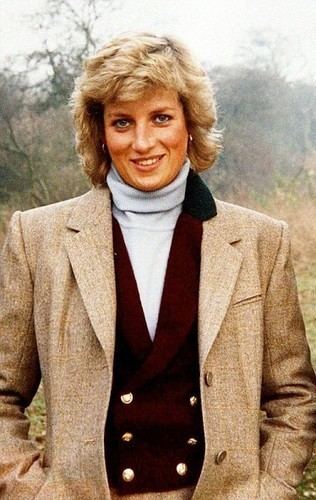 | ||
Style Her Royal HighnessMa'am Website www.princeofwales.gov.uk | ||
Princess of Wales (Welsh: Tywysoges Cymru) is a British courtesy title held by the wife of the Prince of Wales, who is, since the 14th century, the heir apparent of the English or British monarch. The first acknowledged title holder was Eleanor de Montfort, wife of Llywelyn ap Gruffudd. It has subsequently been used by wives of post-conquest princes of Wales.
Contents
- Status of the title
- Other titles of the Princesses of Wales
- Native princesses of Wales
- Princesses of Wales
- References
The title is currently held by Camilla (the former Camilla Parker Bowles), second wife of Charles, Prince of Wales since her marriage on 9 April 2005. She does not, however, use the title, as it has remained strongly associated with the previous holder, the late Diana, Princess of Wales. Instead, she uses the title Duchess of Cornwall.
Status of the title
The Princess of Wales is not a princess in her own right. There have been some Princesses of Wales who were addressed as such; for example, Catherine of Aragon, Alexandra of Denmark, and Mary of Teck were called "Princess Catherine", "Princess Alexandra", and "Princess Victoria Mary" respectively. However, that was because they were already princesses of their ancestral countries when they married: Catherine was a Princess of Aragon (the component kingdom of Spain ruled by her father Ferdinand), and also of Castile (of which her mother Isabella was queen); Alexandra was Princess of Denmark; and Mary was a Princess of Teck because her father was Duke of Teck. Diana, Princess of Wales was commonly called "Princess Diana" following her marriage to Charles, Prince of Wales, but - as Diana herself pointed out - this was incorrect because she was not a princess in her own right.
Although not granted the title in her own right, the future Queen Mary I was, during her youth, invested by her father, Henry VIII, with many of the rights and properties traditionally given to the Prince of Wales, including use of the official seal of Wales for correspondence. For most of her childhood, Mary was her father's only legitimate heir, and for this reason she was often referred to as "the Princess of Wales," although Henry never formally created her as such. For example, Spanish scholar Juan Luis Vives dedicated his Satellitium Animi to "Dominæ Mariæ Cambriæ Principi, Henrici Octavi Angliæ Regis Filiæ".
When a title was discussed for the future Elizabeth II, the possibility of investing her as Princess of Wales in her own right was raised, but proved problematical. If it were used by Princess Elizabeth, it would have degraded her right as a Princess of the United Kingdom unless Letters Patent or legislation were introduced to the contrary. Furthermore, if the then-Princess Elizabeth had been given the title of Princess of Wales, there would have been the problem of what to call her future husband. Therefore, King George VI decided not to grant his elder daughter the title.
Other titles of the Princesses of Wales
The Princess of Wales, by virtue of her marriage to the Prince of Wales, takes on the feminine equivalent of her husband's titles. Thus, upon marriage, the wife of the Prince of Wales assumes the styles and titles – Her Royal Highness the Princess (husband’s Christian name) of the United Kingdom of Great Britain and Northern Ireland, Princess of Wales, Duchess of Cornwall, Duchess of Rothesay, Countess of Chester, Countess of Carrick, Baroness of Renfrew, Lady of the Isles and Princess of Scotland.
Of all these titles, "Princess of Wales" has been used officially, due to its being of a higher rank than the other titles. However, as with the example of the current holder, a subsidiary title may just as easily and lawfully be used.
The Princess is known as Duchess of Rothesay in Scotland, as the Prince of Wales is known as Duke of Rothesay there, the dukedom being the title historically associated with the heir to the Scottish throne. The Princess of Wales also holds the titles of Duchess of Cornwall and Countess of Chester, as the wife of the Prince of Wales who is also Duke of Cornwall and Earl of Chester.
Native princesses of Wales
Several consorts of Welsh princes of Wales were theoretically princesses of Wales while their husbands were in power. Llywelyn ab Iorwerth's consort, Joan, Lady of Wales, used that title in the 1230s; Isabella de Braose and Elizabeth Ferrers were likewise married to princes of Wales, but it is not known if they assumed a title in light of their husbands' status.
The only consort of a Welsh prince definitively shown to have used the title was Eleanor de Montfort, the English bride of Llywelyn ap Gruffudd, the last native Prince of Wales. Their only child was Gwenllian of Wales, who was taken prisoner as an infant following her father's death. Gwenllian was the last native Welsh princess to actually be identified as Princess of Wales; Edward I had her raised in Sempringham Priory in Lincolnshire, far from where any Welsh rebels could find her, and once appealed to the Pope to increase funds to the priory by writing that "...herein is kept the Princess of Wales, whom we have to maintain."
Princesses of Wales
This is a list of Princesses of Wales who held the title by their marriage to the Prince of Wales
